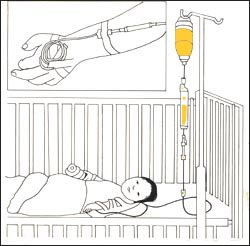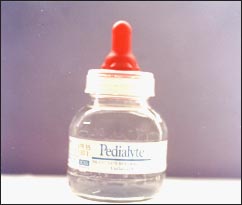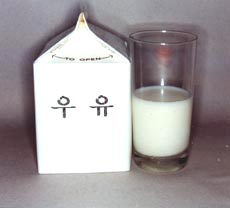바이러스 위장염으로 병원 입원 중 구토, 설사, 탈수의 일반적 치료, Hospital treatments for vomiting, diarrhea and dehydration due to moderate or severe viral gastroenteritis

그림 111. 구토, 설사, 탈수를 포도당 전해질 용액 정맥주사로 재수화 치료도 하고 현상유지 수화치료도 한다.
Copyright ⓒ 2013 John Sangwon Lee, MD., FAAP

사진 112. 때에 따라 구토, 설사, 탈수를 페디아라이트 등 경구용 포도당 전해질 용액으로 재수화 치 료도 하고 현상유지 수화치료를 할 수 있다.
Copyright ⓒ 2013 John Sangwon Lee, MD., FAAP

사진 113. 위장염으로 구토
설사를 할 때 우유를 섭취하면 유당 불 내증으로 더 설사할 수 있다.
Copyright ⓒ 2013 John Sangwon Lee, MD., FAAP
- 구토, 설사, 탈수 등으로 환아가 병원에 입원치료를 받을 때는 담당 의사의 치료 계획에 따 라치료 받는다.
- 구토, 설사, 탈수의 원인, 그로 인해 생긴 증상 징후의 중증도, 환아의 나이 등에 따라 적절한 치료를 담당의로부터 받는다.
- 위장염 등으로 생긴 구토, 설사, 탈수로 병원 입원 치료를 받을 때 부모도 담당 의사가 해주는 치료에 관해 가능하면 많이 알아야 한다.
- 그래서 병원 구토, 설사, 탈수 치료에 관한 일반적 정보에 관해 설명한다.
-
- 구토, 설사, 탈수를 일으킨 원인을 정확히 알고 치료받는 것이 가장 이상적이다
- 때로는 원인을 정확히 알 수 없기 때문에 우선 그 원인을 추정 진단하고 그 추정 진단에 따라 치료를 시작한다.
- 그리고 그 원인으로 생기는 구토 및, 또는 설사 등의 증상 징후를 동시 적절히 대증 치료를 시작하는 것이 보통이다.
- 따라서 구토, 설사, 탈수의 원인에 따라 구토, 설사, 탈수의 치료가 다를 수 있다.
- 예를 들면, 충수염으로 구토, 설사, 탈수가 됐을 때 그 원인 충수염을 수술로 치료하면 구토도 자연히 낫는다.
- 구토 및, 또는 설사의 증상 징후를 동반한 바이러스 위장염을 가정에서 치료할 때와 같이 환아가 한두 번 정도 경미하게 구토할 때는 의사의 지시에 따라 (페디아라이트 등 경구용 포도당 전해질 용액은 제외 하고) 우선 음식물을 2∼4시간 동안 경구로 주지 말고 관찰 치료를 한다.
- 2∼4시간 동안 관찰치료를 하는 동안 더 많이 아프지 않고, 구토나 설사를 경미하게 또는 덜 하는 것 외에 다른 증상 징후가 없으면, 페디아라이트나 다른 종류의 경구용 포도당 전해질 용액을 1회분 30∼120㏄ 정도를 매 2∼4시간마다 경구로 섭취한다. 이런 치료를 약 12∼24시간 동안 한다.
- 그러나 더 심하게 구토 하면 경구용 포도당 전해질 용액이나 그 외 다른 음식물을 경구로 섭취하지 말고 병원 입원치료를 받는다. 병원에서는 포도당 전해질 용액을 정맥주사로 재수화 및 현상 유지 수화치료를 하는 것이 보통이다.
- 위장염 등으로 구토나 설사를 하고 탈수되었을 때는 심하게 갈증이 나기 때문에 맹물이든 그 외 다른 음료수를 마시고 싶어 찾는 것이 보통이다.
- 이 때 맹물이나 심지어는 페디아라이트 등 구용 포도당 전해질 용액을 많이 마시면 구토, 설사, 복통 등의 증상 징후가 심하게 생길 수 있고 그로 인해 더 탈수될 수 있다.
- 구토와 설사가 더 이상 생기지 않고 위장염이 점차로 호전되면 입안을 촉촉이 축이는 정도 페디아라이트 등 경구용 포도당 전해질 용액이나 전 유동 음식물을 조금 주기 시작한다.
- 구토나 설사를 더 하지 않고 위장염이 거의 다 나아가면 그 동안 맞었던 포도당 전해질 용액 정맥주사의 치료용량을 점차로 줄이고 그와 동시에 경구용 포도당 전해질 용액의 양은 12∼24시간 동안 점차로 늘려 준다.
- 정맥 주사로 경구 섭취로 재수화 치료와 현상유지 수화치료를 하는 동안 구토와 설사를 더 이상 하지 않고 위장염이 나아가면 나이에 따라 반 유동 음식물 내지 전 유동 음식물이나 평소 먹던 음식물로 서서히 바꾸어 준다. 그와 동시 포도당 전해질 용액 정맥 주사 치료를 더 이상 하지 않는다.
- 중등도 내지 중증 바이러스 위장염으로 생긴 구토 및 설사 병원 치료의 예이다. 환아의 나이, 체중, 구토, 설사, 탈수를 일으킨 원인과 그 병의 중증도, 합병증의 유무, 다른 상황 등에 따라 다르게 치료할 수 있다.(설사 및, 또는 구토의 일반적 치료법 참조).
General treatment of vomiting, diarrhea and dehydration during hospital admission for viral gastroenteritis,
Hospital treatments for vomiting, diarrhea and dehydration due to moderate or severe viral gastroenteritis

Figure 111. Rehydration treatment for vomiting, diarrhea and dehydration with intravenous glucose electrolyte solution and status quo hydration treatment. Copyright ⓒ 2013 John Sangwon Lee, MD., FAAP

Photo 112. In some cases, vomiting, diarrhea, and dehydration can be treated by rehydration with an oral glucose electrolyte solution such as Pedialyte, and status quo hydration treatment can be performed. Copyright ⓒ 2013 John Sangwon Lee, MD., FAAP

Photo 113. Vomiting with gastroenteritis Consuming milk while having diarrhea can make diarrhea worse due to lactose intolerance. Copyright ⓒ 2013 John Sangwon Lee, MD., FAAP
• When a child is hospitalized for vomiting, diarrhea, or dehydration, it is treated according to the doctor’s treatment plan.
• Get appropriate treatment from your doctor depending on the cause of vomiting, diarrhea, and dehydration, the severity of symptoms, and the age of the child.
• Parents who are hospitalized for vomiting, diarrhea or dehydration caused by gastroenteritis, etc., should know as much as possible about the treatment provided by their doctor.
• So give general information about hospital vomiting, diarrhea and dehydration treatment.
• o It is best to know exactly what caused vomiting, diarrhea, and dehydration and get treatment.
o Sometimes the exact cause is unknown, so the cause is presumed to be diagnosed first, and treatment is started according to the presumptive diagnosis.
o It is common to start symptomatic treatment at the same time and appropriate symptomatic symptoms such as vomiting and/or diarrhea caused by the cause.
• Therefore, depending on the cause of vomiting, diarrhea and dehydration, the treatment of vomiting, diarrhea and dehydration may be different.
• For example, if you have vomiting, diarrhea, or dehydration due to appendicitis, if the cause of appendicitis is treated with surgery, the vomiting will naturally go away.
• When a child vomits once or twice, such as when treating viral gastroenteritis with symptoms of vomiting and/or diarrhea at home, first follow the doctor’s instructions (except for oral glucose electrolyte solutions such as Pedialyte).
Do not give food orally for 2 to 4 hours and observe treatment.
• During observational treatment for 2 to 4 hours, if no more pain and no signs of symptoms other than mild or less vomiting or diarrhea, 30 to 120 servings of Pedialite or another type of oral glucose electrolyte solution ㏄ is taken orally every 2 to 4 hours. This treatment lasts about 12 to 24 hours.
• However, if vomiting is more severe, do not take oral glucose electrolyte solution or any other food orally and seek hospitalization. In hospitals, it is common to administer rehydration and status maintenance hydration with the intravenous glucose electrolyte solution.
• When you are dehydrated after vomiting or diarrhea due to gastroenteritis, it is common to seek out freshwater or other beverages because you are very thirsty.
• If you drink a lot of plain water or even an oral glucose electrolyte solution such as Pedialyte, you may experience severe symptoms such as vomiting, diarrhea, and abdominal pain, which may lead to further dehydration.
• When vomiting and diarrhea no longer occur and gastroenteritis is gradually improved, start giving a small amount of oral glucose electrolyte solution such as Pedialyte or whole liquid food to the extent that the mouth is moistened.
• If gastroenteritis is almost completely resolved without further vomiting or diarrhea, gradually reduce the therapeutic dose of the intravenous glucose electrolyte solution that has been given so far, and at the same time increase the oral glucose electrolyte solution gradually for 12 to 24 hours.
• If gastroenteritis progresses without vomiting and diarrhea during rehydration treatment and maintenance of status quo hydration treatment by intravenous ingestion, gradually change to semi-fluid food, full liquid food, or usual food according to age. Simultaneously, intravenous glucose electrolyte solution is no longer administered.
• Examples of hospital treatment for vomiting and diarrhea caused by moderate to severe viral gastroenteritis. Treatment may vary depending on the child’s age, weight, vomiting, diarrhea, the cause of dehydration, the severity of the disease, the presence or absence of complications, and other circumstances (see General Treatment of Diarrhea and/or Vomiting).
출처 및 참조 문헌 Sources and references
- NelsonTextbook of Pediatrics 22ND Ed
- The Harriet Lane Handbook 22ND Ed
- Growth and development of the children
- Red Book 32nd Ed 2021-2024
- Neonatal Resuscitation, American Academy Pediatrics
-
Pediatric Nutritional Handbook American Academy of Pediatrics
-
소아가정간호백과–부모도 반의사가 되어야 한다, 이상원 저
-
The pregnancy Bible. By Joan stone, MD. Keith Eddleman,MD
-
Neonatology Jeffrey J. Pomerance, C. Joan Richardson
-
Preparation for Birth. Berverly Savage and Dianna Smith
-
임신에서 신생아 돌보기까지. 이상원
-
Breastfeeding by Ruth Lawrence and Robert Lawrence
-
Nelson Textbook of Pediatrics 14th ed. Beherman,
-
The Johns Hopkins Hospital, The Harriet Lane Handbook, 18th edition
-
Red book 29th edition 2012
-
Nelson Text Book of Pediatrics 19th Edition
-
Infectious disease of children, Saul Krugman, Samuel L Katz, Ann A. Gerhon, Catherine Wilfert
-
The Harriet Lane Handbook 19th Edition
-
제9권 소아청소년 소화기 질환 참조문헌 및 출처
-
Pediatric Gastrointestinal Disease, Pathophysiology Diagnosis Management, Wyllie/Hyams 3rd ed.
-
Sources and references on Growth, Development, Cares, and Diseases of Newborn Infants
-
Emergency Medical Service for Children, By Ross Lab. May 1989. p.10
-
Emergency care, Harvey grant, and Robert Murray
-
Emergency Care Transportation of Sick and Injured American Academy of Orthopaedic Surgeons
-
Emergency Pediatrics A Guide to Ambulatory Care, Roger M. Barkin, Peter Rosen
-
Quick Reference To Pediatric Emergencies, Delmer J. Pascoe, M.D., Moses Grossman, M.D. with 26 contributors
-
Neonatal resuscitation American academy of pediatrics
-
소아과학 대한교과서
-
그 외
Copyright ⓒ 2014 John Sangwon Lee, MD., FAAP
“부모도 반의사가 되어야 한다”-내용은 여러분들의 의사로부터 얻은 정보와 진료를 대신할 수 없습니다.
“The information contained in this publication should not be used as a substitute for the medical care and advice of your doctor. There may be variations in treatment that your doctor may recommend based on individual facts and circumstances.
“Parental education is the best medicine.